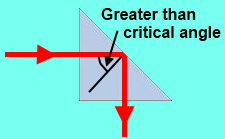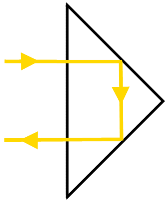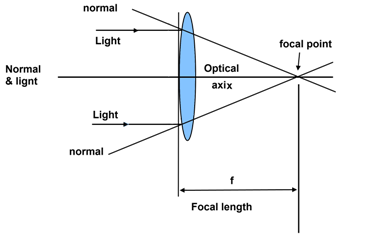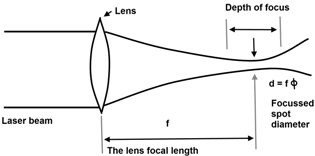Laser Accessories Part 1 (Prism & Lens)
Mostly the laser is not used by itself but rather, it is combined with a number of accessories and used as part of larger system. The elaborate systems consisting of lenses, mirrors, prism, computer controllers and a vast array of electromechanical devise such as Q-switches etc. Therefore it is necessary to explain these accessories function and advantages. The most common accessories used with lasers are listed below.
- Prism
- Lenses
- Collimators
- Reflective mirrors
- Optical fiber
- Etalon
- Brewster window
- Q-Switch
- Detectors
Prisms
The prism is a solid glass triangle and can be use for many purposes such as for separation of wavelengths and as a mirror etc. Due to these purpose prisms are considered as optical accessories.
Prism as wavelength Separator
When light strikes the plane of glass, then light beam separated into its component wavelengths because the index of refraction for glass is slightly different from each wavelength of light. And we know that according to Snell’s law each wavelength will refract at slightly different angle. Now with a flat sheet of glass this separation is not noticeable because in flat sheet of glass the surface is parallel. Therefore a prism is designed to overstate this separation, resulting in classic spectral display. That is why the prism is used as a wavelength separator.
By diagram prism as a wavelength separator can be shown as:

This figure explains two points i.e. A and B.
When the light travels from a medium with low refraction index to the medium with a high refractive index then light beam will be refracted towards the normal. Since the refractive index of the medium varies with the frequency of the light source therefore the component wavelengths of light beam will be refracted at different angles. This is shown at point-A.
On the other hand when light travels through the prism and exits on the opposite side, then this is the case of light traveling from high refractive index medium to low refractive index medium. So this results bending the beam away from the normal. This is shown at point-B.
In this way the prism separates the various wavelengths in the beam of light. In Argon laser prism is used for this purpose.
Prism as a Mirror
The prism can also be used as a mirror. In this case the concept of total internal reflection is employed. Here the light must enter to the prism and strike the back side of the prism at an angle greater than the critical angle. This causes the light to reflect back into the prism.
As a mirror, the prism can be used in two different orientations.
1st can be shown as

Here the prism acts as a mirror that changes the direction of the travel of the light beam by 90o. Clearly the light beam enters and exits the prism in direction of travel that is perpendicular to the sides of the prism. In this case no refraction occurs and the light beam does not split.
2nd can be shown as

Here the prism is used to change the direction of travel of the light beam by 180o. Again the light beam is perpendicular to the prisms surface when it inters and exits the prism. Therefore no refraction or beam separation occurs.
Lenses
Most of the lenses in general use today are made of optical glass of which there are several hundred types. All these types lie in two basic categories. That is converging and diverging lens. Each lens utilizes the principle of refraction to manipulate light.
Converging Lenses
A converging lens brings together all incident light rays at a specific point. The surface of this type of lens is curved with the center of the lens thicker than the edges. A typical converging lens and its characteristics can be shown as

Note: Any lens which causes light to converge may also be called the positive lens.
Note that the incident light is parallel to the optical axis. In above figure there are three normal shown where the incident light strikes the surface of the lens. This is done for case of explanation. Actually there are an infinite number of the normal associated with the curved surface of the lens. As a result the angle of refraction for each incident ray of light is greater as approaches the edge of the lens. The light ray is again refracted as they exit the lens. This causes the entire light ray to converge at some point after they exit the lens. Now the point where the entire light ray converges after they exit the lens is called the focal point. The position of the focal point is determined by the curve of the lens surface. If the lens has a sharp curve then amount of refraction is much greater and the focal point will be closer to the lens.
On the other hand a gradual curve results in less refraction and a focal point which is farther from the lens.
The above figure also defines clearly the focal length as:
“The distance from the lens first surface to the focal point is called focal length of lens”.
When the lens is thick lens than focal length of lens is shown by figure as:

This type of focal pattern is usually made, when the light entering the lens is parallel to the optical axis. Now if the light enters the lens off axis, then it is focused to a point above or below the focal point. This can be shown as:

Since the incoming rays to lens are parallel to each other, therefore the light entering the lens is referred to as parallel light. In other words there is no divergence of incoming light. The laser light presents the close approximation to this situation, but we know that even the best laser has some divergence. Therefore the spot formed at the focal point is not infinitely small as in previous case we show.
For any given lens, there is smallest possible spot size at the focal point. This spot size is a function of
- Quality of lens.
- The divergence of the beam entering the lens and
- The wave length of the incident light.
The smallest possible spot size is called the diffraction limited spot size, which can be found by a formula.
Focal spot size = lens focal length X divergence
>> d = f X ɸ ---------------------------eq.1
All representations above of the focal pattern were only theoretical, so the true representation of focal pattern of light beam entering a converging lens is shown as:

Clearly in true representation, the spot size has a finite diameter, which is calculated from Eq.1 .
Here we also see that focal point is not well defined point and there is a region near it where the beam diameter is approximately the same as it is exactly at the focal point. This region is called the depth of focus.
Since near the focal point of the lens, there is an area in which the beam diameter does not change to any great extent. Therefore the irradiance of the beam remains nearly the same throughout the depth of focus. So in most of applications, it would be satisfactory to use any portion of this beam segment.
Diverging Lens
The diverging lens causes parallel light rays to diverge or spread out. In this type of lens the outer edges is always thicker than the center of lens.
A typical diverging lens and its characteristics can be shown as:

As in converging lens case, here also the surface of the diverging lens is consisting of number of point, each having its own normal but for simplicity we take only three.
When the incident light strikes the surface of the lens then it is refracted and spread out. This spread becomes even clearer when the light is once again refracted as it exits the lens.
Remember that there is also a focal point for diverging lens but it is the point from which the light appears to diverge. The focal point for the diverging lens is located on the side of the lens closest to the source of light and so called as virtual or negative focal point.
Importantly Note That
There are number of variations of lenses lies in the two lenses categories. For example
Converging lens variations / types are

Diverging lens variations / types are:

Every lens presented has been spherical if form. Some lenses may be cylindrical in shape. For example

